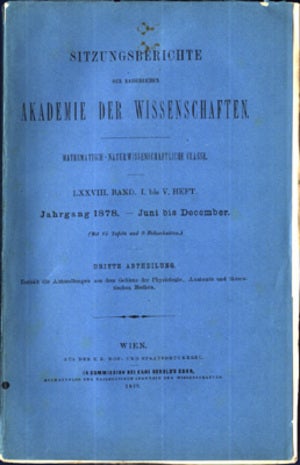
Uber Spinalganglien und Ruckenmark des Petromyzon.
Publisher Information: 1879. Freud, Sigmund (1856-1939). Uber Spinalganglien und Ruckenmark des Petromyzon. In Sitzb. der k. Akad. d. Wissenschaften, 3 Abth., 78 (1879): 81-167. 4 plates by F. Schima after Freud. Whole volume, 8vo. v, [1], 289pp. Plates. 244 x 156 mm. (uncut & unopened). Original printed wrappers. Slight foxing but fine. Book Id: 38942 First Edition. Freud's third paper published as a medical student continued his research on the large Reissner cells in the spinal cord of the fish Petromyzon, which he had undertaken at the direction of the eminent physiologist Ernst Brucke, under whom he was studying. Freud determined these cells to be "nothing else than spinal ganglion cells which, in these low vertebrates. . . remain within the spinal cord." Freud was aided in this research by his improved methods of tissue preparation: "By the use of a gold maceration technique it was possible to make a complete survey of the spinal ganglia of Petromyzon" (Freud, Standard Edition III, p. 229). Freud made a major contribution to evolutionary biology by showing that the spinal ganglion cells of Petromyzon, which "exhibit every transition between bipolarity and unipolarity" (ibid.), represent a transition between the bipolar cells of lower and the unipolar cells of higher vertebrates. He also, in these early researches, took some first steps toward the theory of the neuron, as noted by Freud's biographer Peter Gay: Some of Freud's earliest published papers, written between 1877 and 1883, detail findings that are far from trivial. They substantiate evolutionary processes revealed in the nervous structures of the fish he was examining under his microscope. What is more, it becomes clear in retrospect that these papers form the first link in the chain of ideas leading to the draft of a scientific psychology he would attempt in 1895. Freud was working toward a theory specifying the ways that nerve cells and nerve fibrils function as a unit. But he moved on to other investigations, and when, in 1891, H. W. G. Waldeyer published his epoch-making monograph on the "neuron" theory, Freud's pioneering research was ignored. "It was not the only time," Ernest Jones has noted, "that Freud narrowly missed world fame in early life through not daring to pursue his thoughts to their logical-and not far off-conclusion" (Gay, Freud: A Life for our Time, p. 36). Freud's paper was submitted to the Sitzb. der k. Akad. d. Wissenschaften in 1878 and printed in the June-December volume for that year, published in 1879. The offprint of Freud's paper is dated 1878. Grinstein 34. Jones I, pp. 52-53. Standard Edition 1878a. Norman F3.
Price: $1,250.00
